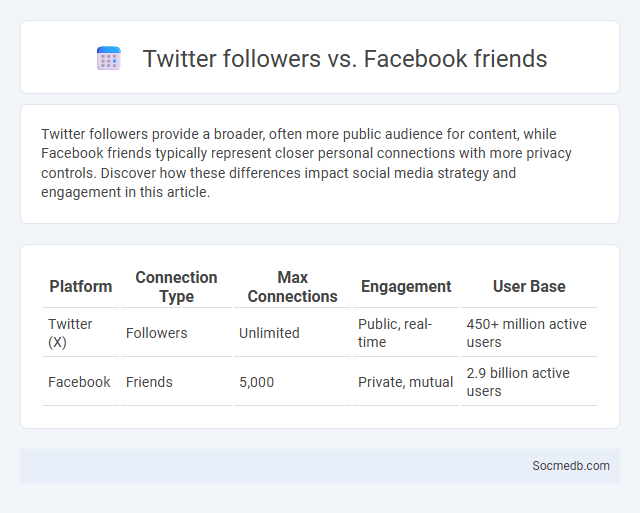
Photo illustration: Twitter followers vs Facebook friends
Twitter followers provide a broader, often more public audience for content, while Facebook friends typically represent closer personal connections with more privacy controls. Discover how these differences impact social media strategy and engagement in this article.
Table of Comparison
| Platform | Connection Type | Max Connections | Engagement | User Base |
|---|---|---|---|---|
| Twitter (X) | Followers | Unlimited | Public, real-time | 450+ million active users |
| Friends | 5,000 | Private, mutual | 2.9 billion active users |
Overview: Twitter Followers, Facebook Friends, and Followers
Twitter followers and Facebook friends represent key metrics in measuring social media reach and engagement. While Twitter followers indicate the number of users who receive your updates in their feed, Facebook friends encompass a mutual connection allowing more personalized interactions. Both platforms provide unique opportunities for building online communities and amplifying brand visibility.
Key Differences Among Social Media Connections
Social media connections vary fundamentally in their nature and purpose, including strong ties such as close friends and family, weak ties like acquaintances, and latent ties representing dormant or potential connections. Strong ties facilitate trust, emotional support, and frequent interactions, while weak ties provide access to diverse information and broader networks. Latent ties can be activated to expand reach and influence, making understanding these distinctions crucial for effective social media networking and engagement strategies.
How Twitter Followers Work
Twitter followers represent users who have chosen to subscribe to your account updates, allowing your tweets to appear in their feed. The number of followers influences your reach and engagement, as more followers typically result in greater visibility and interaction on your content. Understanding how Twitter followers work helps you tailor your strategy to grow Your online presence effectively.
Understanding Facebook Friends
Facebook friends represent connections that enable users to share content, communicate, and engage with a broad network of individuals. Understanding the dynamics of Facebook friendships involves analyzing interaction frequency, mutual interests, and privacy settings to tailor content visibility effectively. These factors contribute significantly to the platform's algorithm, influencing news feed rankings and user experience.
Who Are Social Media "Followers"?
Social media followers are individuals who subscribe to or regularly view content from a specific user, brand, or organization on platforms like Instagram, Twitter, or Facebook. These followers engage with posts through likes, comments, shares, and direct messages, contributing to digital visibility and influence metrics. Brands and influencers analyze follower demographics and behavior to tailor content strategies and enhance audience retention.
Engagement Levels: Followers vs. Friends
Engagement levels on social media platforms often vary significantly between followers and friends, with followers typically providing broader reach but lower interaction rates. Friends, or direct connections, tend to have higher engagement rates due to stronger personal relationships and increased trust. Analyzing metrics such as likes, comments, and shares reveals that friends usually contribute to more meaningful interactions compared to the passive engagement of followers.
Privacy and Connection Settings Compared
Social media platforms offer diverse privacy and connection settings that control user visibility and interaction scope. Privacy settings typically include options for profile visibility, data sharing permissions, and content access restrictions, empowering users to tailor their online footprint. Connection settings manage friend requests, follower lists, and communication preferences, enhancing personalized networking while safeguarding user data.
Impact on Content Reach and Visibility
Social media algorithms prioritize engaging content, significantly affecting content reach and visibility for brands and creators. High user interaction, such as likes, comments, and shares, boosts the likelihood of content appearing on users' feeds and explore pages. Paid promotions and trend-driven hashtags further amplify content distribution, extending reach beyond organic followers.
Building Your Online Network: Strategies for Each Platform
Maximize your online presence by tailoring strategies for each social media platform to build a strong network. On LinkedIn, focus on professional connections through personalized messages and consistent content sharing, while Instagram thrives on engaging visuals and interactive stories to attract followers. Twitter's fast-paced environment requires concise, timely posts and active participation in trending conversations to expand your reach.
Which Platform Suits Your Social Media Goals?
Choosing the right social media platform depends on your specific goals, such as brand awareness, audience engagement, or lead generation. Instagram excels in visual storytelling and influencer marketing, while LinkedIn is ideal for B2B networking and professional growth. Facebook offers robust advertising tools and community-building features to enhance customer interaction and drive conversions.
 socmedb.com
socmedb.com